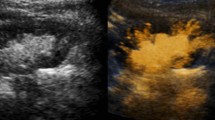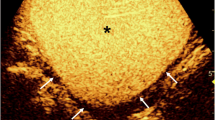Abstract
Background: Contrast-enhanced voiding urosonography (VUS) is largely accepted both for the diagnosis and follow-up of vesicoureteric reflux (VUR) in children. Objective: To evaluate the usefulness of contrast-enhanced second-harmonic VUS in the diagnosis and grading of VUR, using a second-generation contrast agent. Materials and methods: Eighty consecutive children were prospectively studied with contrast-enhanced second-harmonic VUS. All children received a second-generation contrast medium, constituted by phospholipid-stabilized microbubbles of sulphur-hexafluoride (SonoVue, Bracco, Milan, Italy). US monitoring of the bladder, of the retrovesical space and of the kidneys was performed using, alternatively, both tissue-harmonic and contrast-harmonic modes. In those young boys where VUR was depicted at VUS, examination was completed with transperineal, sagittal urethral exploration during micturition. VUR was graded in five steps and diagnoses were compared with voiding cystourethrography (VCUG). Results: VUR was diagnosed in 52 reno-ureteral units with VUS. In 49 of these reno-ureteral units, VCUG confirmed the presence of VUR. In comparison to VUS, sensitivity and negative predictive value of VCUG were inferior. The grade of VUR detected at VUS was higher than that detected at VCUG in three units. In no case was the grade of VUR detected at VCUG higher than the one detected at VUS. The differences between VUS and VCUG in grading VUR were statistically significant (p=0.02). Imaging of the normal posterior urethra was skilfully demonstrated with US in 15 young boys with VUR. No statistically significant differences were found between tissue-harmonic and contrast-harmonic mode (p=0.102). Conclusions: Contrast-enhanced second-harmonic VUS is a sensitive and easy technique for the evaluation of VUR. A second-generation US contrast medium such as SonoVue, if available, should be the first choice as the dose required for one examination is much lower and consequently significant reduction of contrast agent cost is possible.




Similar content being viewed by others
References
Bosio M (1998) Cystosonography with echocontrast: a new imaging modality to detect vesicoureteric reflux in children. Pediatr Radiol 28:250–255
Darge K, Troeger J, Duetting T, et al (1999) Reflux in young patients: comparison of voiding US of the bladder and retrovesical space with echo enhancement versus voiding cystourethrography for diagnosis. Radiology 210:201–207
Mentzel HJ, Vogt S, Joan U, et al (2002) Voiding urosonography with ultrasonography contrast medium in children. Pediatr Nephrol 17:272–278
Farina R, Arena C, Pennisi F, et al (2000) Vesico-ureteral reflux: diagnosis and staging with voiding color Doppler US. Preliminary experience. Eur J Radiol 35:49–53
Haberlik A (1997) Detection of low-grade vesicoureteral reflux in children by color Doppler imaging mode. Pediatr Surg 12:38–43
Ascenti G, Chimenz R, Zimbaro G, et al (2000) Potential role of color-Doppler cystosonography with echocontrast in the screening and follow-up of vesicoureteral reflux. Acta Paediatr Scand 89:1336–1339
Riccabona M (2002) Cystography in infants and children: a critical appraisal of the many forms with special regard to voiding cystourethrography. Eur Radiol 12:2910–2918
Novljan G, Kenig A, Rus R, et al (2003) Cyclic voiding urosonography in detecting vesicoureteral reflux in children. Pediatr Nephrol 18:992–995
Valentini AL, Salvaggio E, Manzoni C, et al (2001) Contrast-enhanced gray-scale and color Doppler voiding urosonography versus voiding cystourethrography in the diagnosis and grading of vesicoureteral reflux. J Clin Ultrasound 29:65–71
Darge K, Ghods S, Zieger B, et al (2001) Reduction in voiding cystourethrographies after the introduction of contrast enhanced sonographic reflux diagnosis. Pediatr Radiol 31:790–795
Berrocal T, Gaya F, Arjonilla A, et al (2001) Vesicoureteral reflux: diagnosis and grading with echo-enhanced cystosonography versus voiding cystourethrography. Radiology 221:359–365
Uhl M, Kromeier J, Zimmerhackl LB, et al (2003) Simultaneous voiding cystourethrography and voiding urosonography. Acta Radiol 44:265–268
Piaggio G, Degl’Innocenti ML, Toma P, et al (2003) Cystosonography and voiding cystourethrography in the diagnosis of vesicoureteral reflux. Pediatr Nephrol 18:18–22
Kenda RB, Novljan G, Kenig A, et al (2000) Echo-enhanced ultrasound voiding cystography in children: a new approach. Pediatr Nephrol 14:297–300
Ascenti G, Zimbaro G, Mazziotti S, et al (2003) Vesicoureteral reflux: comparison between urosonography and radionuclide cystography. Pediatr Nephrol 18:768–771
Bosio M, Manzoni GA (2002) Detection of posterior urethral valves with voiding cystouretrosonography with echo contrast. J Urol 168:1711–1715
Matè A, Bargiela A, Mosteiro S, et al (2003) Contrast ltrasound of the urethra in children. Eur Radiol 13:1534–1537
Talenti E, Piaggio G, De Filippi C, et al (2001) Il ruolo della cistosonografia nella diagnosi e nel follow-up delle uropatie malformative. Riv Ital Pediatr 27:290–296
Darge K, Zieger B, Rohrschneider W, et al (2001) Contrast-enhanced harmonic imaging for the diagnosis of vesicoureteral reflux in pediatric patients. AJR 177:1411–1415
Darge K (2002) Diagnosis of vesicoureteral reflux with ultrasonography. Pediatr Nephrol 17:52–60
Spinazzi A (2001) Emerging clinical applications for contrast-enhanced ultrasonography. Eur Radiol 11(Suppl 3):E7–E12
Nakamura M, Wang Y, Shigeta K, et al (2002) Simultaneous voiding cystourethrography and voiding urosonography: an in vitro and in vivo study. Clin Radiol 57:846–849
Atala A, Ellsworth P, Share J, et al (1998) Comparison of sonicated albumin enhanced sonography to fluoroscopic and radionuclide voiding cystography for detecting vesicoureteral reflux. J Urol 160:1820–1822
Lebowitz RL, Olbing H, Parkkulainen KV, et al (1985) International system of radiographic grading of vesicoureteral reflux. Pediatr Radiol 15:105–109
Somes G (1983) McNemar test. In: Kotz S, Johnson N (eds) Encyclopedia of statistical sciences. Wiley, New York, pp 361–363
Mentzel HJ, Vogt S, Patzer L, et al (1999) Contrast-enhanced sonography of vesicoureteral reflux in children: preliminary results. AJR 173:737–740
Correas JM, Bridal L, Lesavre A, et al (2001) Ultrasound contrast agents: properties, principles of actions, tolerance, and artefacts. Eur Radiol 11:1316–1328
Rizzatto G, Martegani A, Chersevani R, et al (2001) importance of staging of breast cancer and role of contrast ultrasound. Eur Radiol 11(Suppl 3):E47–E52
Author information
Authors and Affiliations
Corresponding author
Rights and permissions
About this article
Cite this article
Ascenti, G., Zimbaro, G., Mazziotti, S. et al. Harmonic US imaging of vesicoureteric reflux in children: usefulness of a second generation US contrast agent. Pediatr Radiol 34, 481–487 (2004). https://doi.org/10.1007/s00247-004-1190-z
Received:
Revised:
Accepted:
Published:
Issue Date:
DOI: https://doi.org/10.1007/s00247-004-1190-z




